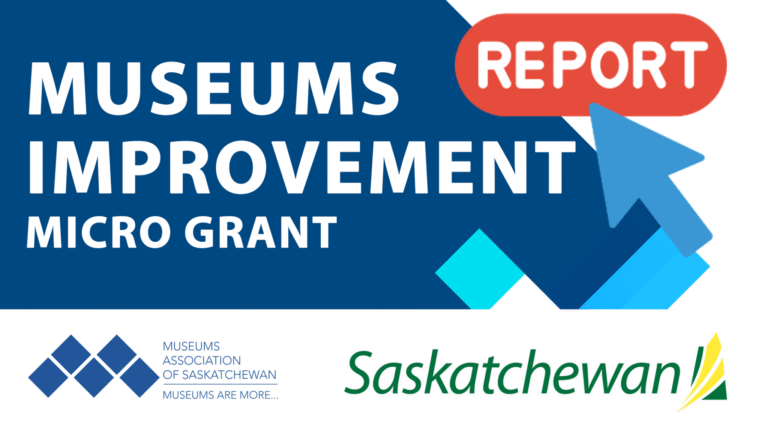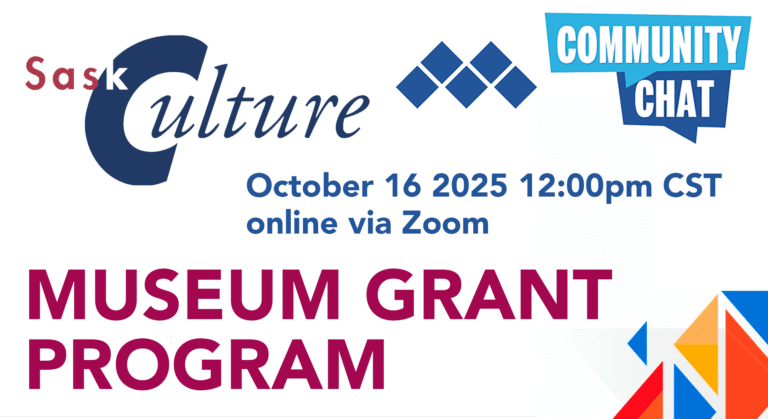
The MAS office will be closed for Christmas Holidays December 24th to January 4th.
Usual office hours will resume on January 5th, 2026
Online Programming at the Saskatchewan Sports Hall of Fame
In conversation with Vickie Krauss, Administrative Assistant/Education Coordinator, Saskatchewan Sports Hall of Fame
The early days of COVID-19:
When the Saskatchewan Sports Hall of Fame (SSHF) made the decision to remain closed to the public until such a time when they felt it was safe (for their staff, volunteers, and public) to re-open, Vickie Krauss had to rethink what programming would be like from there on out. Programming prior to COVID-19 was much as it was elsewhere; in-person.
As the Education Coordinator, Vickie hit the ground running. What was the quickest and easiest way to accommodate their regular programming in this new reality? To connect school groups directly with Saskatchewan Sports Hall of Fame inductees? Vickie immediately thought of pen pals, students could write e-mails, letters, or have video calls with inductees. She had a great response from inductees who wanted to participate in corresponding with school groups. There were six classrooms interested but, in the end, only three classrooms and one individual were able to connect with four different inductees.
It might not seem like a lot, but it was a start.
Making the move to online programming:
By the fall teachers had a better grasp on managing virtual learning, so Vickie started putting content online. By November the SSHF was doing virtual tours. To continue to share their stories they adapted the exhibition Prairie Pride: A History of Saskatchewan Football to a live virtual tour and eventually into a 360° virtual tour, which will remain online, archiving the exhibition for an undetermined amount of time. In May they won the Canadian Association for Sport Heritage Award for Excellence for their exhibition Prairie Pride: A History of Saskatchewan Football and its adaptions into a live virtual tour as well as an online tour.
Once these tour options were available online programming picked up. It was slow going at first, with a grand total of two tours in November and December, but because of the virtual option, a tour could be comprised of two, three, or four classrooms, making tours of 82 students at a time possible.
Using her smartphone and whichever platform the school uses (Zoom, Google Meet, Microsoft Teams, or Webex), Vickie would walk around giving a guided tour of all the exhibit galleries tailored to the interests of the group(s). Either sharing stories, following pre-determined themes, or emphasising the curriculum tie-ins specific to the grades attending the tour. Being able to provide adaptable tours, outside of the general tour, enhanced the offerings available to schools.
By reaching out to teachers that had previously brought classes for field trips to the museum, contacting the head offices of different school divisions, and advertising these tours on social media, Vickie saw 34 different classrooms (about 930-odd students) from all over Saskatchewan. Most were based in Regina, but schools from Yorkton, Saskatoon, and North Battleford attended as well.
They also adapted their mobile travelling exhibit, that had previously been used for Never Give Up where their mobile exhibit trailer would tour around the province to provide in-person, hands-on experiences to school children), for virtual delivery. This year’s Never Give Up ran for six weeks in May and June. It featured three inductees, Ted Jaleta, Lisa Franks, and Colette Bourgonje, who over the course of those six weeks, would give presentations on their stories as athletes and the challenges they overcame to pursue their dreams. Each featured athlete gave four separate talks, meaning there were 12 sessions over six weeks for classes to sign-up to attend. There was a phenomenal response; 900 students from 12 different schools all over Saskatchewan (Lloydminster, Quill Lake, Nokomis, etc.), and there was a waitlist of 17 schools wanting to join.
Programs offered:
Virtual Field Trips – Vickie tailored each tour to meet particular curriculum objectives depending on the grades of students on the tours. Ideas such as sharing stories, emphasising the curriculum outcomes like, famous people in sport history, technology in sport, or patterns in sport for the younger age groups. Curriculum tie-ins are something Vickie tires to emphasis as a selling point for all of the SSHF education content. As a result, each tour was unique to the group and included all of the gallery space and exhibitions including Prairie Pride: A History of Saskatchewan Football, the new STEM Interactive Gallery sponsored by SaskTel, Dedication to Sport and Honoured Members galleries.
STEM in Sport Experiment – the new STEM Interactive Gallery, sponsored by SaskTel, explores how Science, Technology, Engineering, and Math are connected to sports. The STEM Interactive Gallery is also available as a 360° virtual tour online, and additional resources of “how-to” and “experiment” videos are available, not to mention the curriculum tie-in lesson plans for grades 4 – 12 that are conveniently available on their website for easy access by educators. This allows teachers and their students to participate at their convenience independently.
Never Give Up – Three inductees gave four presentations each over a span of six weeks (12 sessions in total) directly to school groups. These athletes would discuss their lives, experiences, and their passionate pursuit of their sport with school groups via video chat and had plenty of time for questions and interaction with the inductee.
Vickie has also put Lesson Plans fully accessible on the SSHF website along with Additional Resources for Teachers, which include a variety of games and activities. The lesson plans clearly indicate the objectives and educational outcomes, outlining the lesson (by grade).
Creating Active Champions – the summer program Creating Active Champions returned for another year of virtual delivery, livestreaming to the SSHF Facebook page so that participants could follow along from anywhere. This program caters to young children, the majority of participants in the past being day cares. In honour of the 2021 Summer Olympics, this year’s Creating Active Champions has a distinctly Olympic theme tied into their activities. Sessions were held twice a day, in the morning at 10am and the afternoon at 1:30pm. This program combines demonstrations of stretches and exercises (which encourage kids to stay active at home), and focused on an Olympic or Paralympic sport each day. Some days were with guided tours of the exhibitions, with particular attention paid to anything and anyone with Olympic ties, as well as downloadable activities (colouring pages, mazes, wordsearches, etc.) that were added to throughout the program, available on the SSHF website.
What does the future of programming look like?
Online has its merits, as it enables you to connect to Saskatchewan athletes and inductees out of Regina as well as schools and classrooms anywhere.
This year offered the opportunity to partner with other organisations to deliver programs to reach an even wider audience, like the Saskatchewan Olympian panel done with the Regina Public Library.
The SSHF hopes to keep up with their virtual tours and online content. Being online has been a great way to stay in contact with the community, and fulfill its mandate to spread the history of sport in Saskatchewan to the whole province. It has been a collaborative effort by the museum staff as well, with everyone being involved at some level and stage, creating the exhibits or online content, obtaining funding and advertising on social media. It takes an entire team to make things work!
For now, looking at the Fall, the SSHF will be continuing with their online programming and adding some more new and exciting content. Nobody is quite sure what schools will be doing, whether or not they will feel comfortable to visit for in-person tours. So, keeping those online options is very important.
Virtual/online programming has been great advertising for what the SSHF has to offer.
Website: https://sasksportshalloffame.com
Facebook: www.facebook.com/SaskSportsHF
Instagram: @SaskSportsHF
Twitter: @SaskSportsHF
In summary:
Tip:
No idea is a bad idea – you have to put things out there to see if there is interest. Maybe it is a test group. Find out what would work, or what doesn’t work. Give things a whirl, if it works great, if it doesn’t, move on.
Reach out to teachers and school districts and other potential visitors to grow you audience.

Usual office hours will resume on January 5th, 2026

Just a reminder that the Final Report for the Museum Improvement Micro Grant for Community Museums is due December 5th! Your final report will require you to provide a brief

Thursday October 16, 202512:00pm CSTOnline via Zoom: https://us02web.zoom.us/j/86760471705?pwd=XjoSlWAP0TJZVYrprylmLqujOkVrk2.1 No registration required. The Museum Grant Program (MGP) provides operational funding to help foster strong, vibrant, community-based Saskatchewan museums that are valued